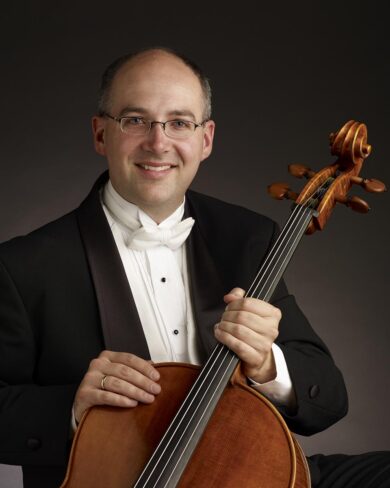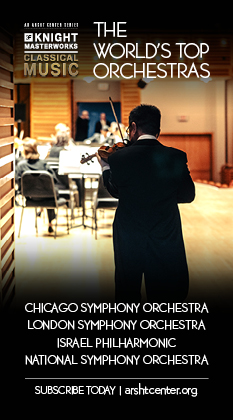Kosower, Raharjo prove a superb team in Coral Gables

Cellist Mark Kosower performed Thursday night at Coral Gables Congregational United Church of Christ.
Some cellists emphasize virtuosic skill. Others evidence depth of emotional projection.
Then there are the instrument’s singular patricians. Mark Kosower belongs to the latter group and his pristine musicianship was fully on display Thursday night in a recital for the Community Arts Program at Coral Gables Congregational United Church of Christ.
Principal cellist of the Cleveland Orchestra, Kosower avoided tried-and-true fare in favor of more diverse scores. With Beethoven as a prelude, his illuminating program featured four rarely performed works by twentieth m-century composers.
Beethoven’s Cello Sonata in G minor, Op. 5, no.2 is an early work that finds the composer paying tribute to Haydn while offering early evidence of the drama and struggle that would characterize his mature masterpieces. In the opening slow introduction and ensuing Allegro molto, Kosower’s depth of tone, impeccable intonation and sculpted phrasing captured the music’s conflicting thematic patterns, alternately joyous and dramatic. Kosower’s vigorous bowing and bracing attack brought out the wit of the concluding Rondo.
In the Beethoven sonata and throughout the program, pianist Melivia Raharjo was a full partner rather than mere accompanist. A collaborative pianist at the Cleveland Institute of Music, Raharjo’s svelte touch, musicality and astute blending displayed outstanding chamber skills. Kosower and Raharjo were totally en sync, shaping musical paths as if in one heartbeat,
Lamentations: Black Folk Song Suite for solo cello by Coleridge-Taylor Perkinson (1932-2000) was a Bachian cello suite with tinges of blues, jazz and ragtime adding spice. The initial “Fuguing Tune” mixes Baroque counterpoint with populist currents. Kosower’s scrupulous attention to articulation, dynamics and tonal shifts cast a spotlight on Perkinson’s fusion of structural mastery and engaging rhythmic propulsion. He drew a wealth of expressive feeling from the instrumen in “Song Form,” a modern day sarabande cum hymn. In the pizzicato writing of “Calvary Ostinato,” Kosower’s plucked figurations ranged from near inaudibility to strongly decisive fortes. The “Perpetual Motion” finale found Kosower delivering relentlessly agitated fragments at top speed in a demonstration of dexterity and technical aplomb.
Ernst Krenek (1900-1991) was one of the “bad boys” of European music during the Weimar era. His 1925 opera Jonny spielt auf was audacious for incorporating jazz and a black protagonist as part of a classical music theater creation. Following the rise of Hitler and Nazism, the Austrian composer emigrated to the United States where he taught at numerous universities and conservatories.
Krenek’s Suite for solo cello, written in 1939, fuses romanticism and traditional musical forms (such as a waltz and march) with atonality. Kosower managed to showcase the off-kilter charm of Krenek’s creation. He drew out the understated passion of the Andante affettuoso The second movement Adagio resounds like a ballroom waltz through a twelve-tone scrim and Kosower’s lightness of bow marked the distorted thematic strains to perfect effect. His edgy precision captured the grim aura of the Andante scherzando. The final Andante seemed like a romanza from a different musical solar system, given a decisive individual voice in Kosower’s vivid reading.
The Sonata No. 2 in A minor for cello and piano by Nikolai Myaskovsky (1881-1950) recalled the rich melodic felicity and heart-on-sleeve passion of Tchaikovsky. While Myaskovsky’s sonata looks backward to a previous Russian style and era, it avoids being derivative.
The haunting principal theme of the first movement found Kosower invoking the score’s imperial Russian ethos while avoiding exaggerated bathos. Raharjo’s spaciously shaped solo sections were equally idiomatic and eloquent. The Andante cantabile unfurled in one those lustrous melodic outbursts one expects from Rachmaninoff with keyboard flourishes to match. Kosower and Raharjo’s nuanced approach allowed the music to speak directly, bereft of interpretive excess.
There is more than a slight similarity to the main subject of the concluding Allegro con spirito and the finale of Tchaikovsky’s Rococo Variations. With robust projection at a fierce clip, the players had the pyrotechnics well in hand.
Bohuslav Martinu’s Variations on a Theme of Rossini proved a light, tasty dessert. A jaunty theme is transformed through a series of high-voltage permutations that test the player’s technique, concentration and sheer strength. Kosower, with fiery support from Raharjo, was fully equal to the task.
Repeated standing ovations brought the duo back for an eloquently stated version of Brahms’ Hungarian Dance No. 1, a fine coda to an enterprising and strongly performed recital.
The Community Arts program presents the Sinta Quartet playing works by Dvořak, Ligeti, Béla Fleck, et al. 7:30 p.m. August 3 at Coral Gables Congregational United Church of Christ. link.protect.cudavc.com
Posted in Performances
Leave a Comment
Fri Jun 23, 2023
at 12:44 pm
No Comments



